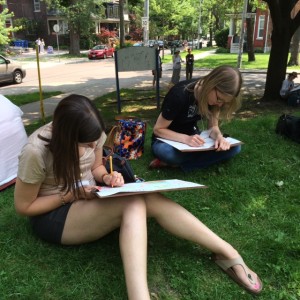I taught a professional development course for teachers from the Toronto District School Board in July – always a pleasure to work with teachers who are so passionate about environmental learning that they give up three weeks of their summer vacation to learn more about it! I was pleasantly surprised to see such an interest in environmental art-making ã there were lots of great ideas shared around the table, evidence of the experimentation going on in Toronto schools about how to use the arts to support eco-literacy. Many expressed their enjoyment of the ãsensory mappingã activity we did on our first day together ã such a simple way to get learners to connect with and reflect on the power of place-based education. The teachers were asked to capture their sensory experience of the local park into the form of a pastel drawing. This requires them to consider how a sound translates into a line, a touch into a colour, or a smell into a shape. This proved to be a great way to get them to focus on the place, and to remove the inhibition that some have about drawing as all of the drawings turn out abstractly. Later in the course we talked about the power of ãcreative mappingã, drawing on the books The Map as Art (by Katherine Harmon) and Mapmaking with Children (by David Sobel.) Mapping and sensory experience can go hand in hand to help learners of all ages experience the environments in which we live in creative ways.
Mapping Sensory Experiences of Place
Posted August 11th 2015 at 7:46 pm by HilaryInwood
You can follow any responses to this entry through the RSS 2.0 feed.
You can skip to the end and leave a response. Pinging is currently not allowed.
There are no comments yet, be the first to say something



